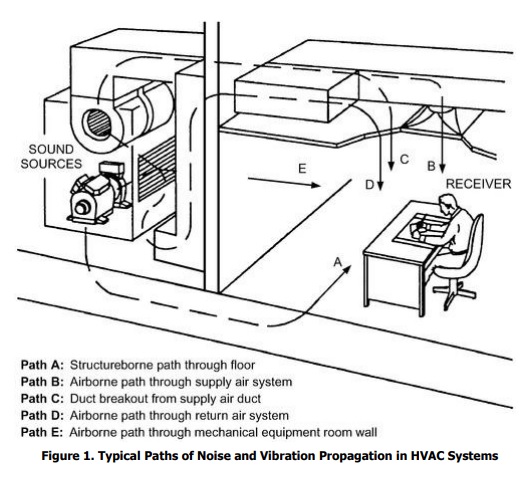HVAC equipment for a building is one of the major sources of interior noise, and its effect on the acoustical environment is important. Further, noise from equipment located outdoors often propagates to the community. Therefore, mechanical equipment must be selected, and equipment spaces designed, with an emphasis on both the intended uses of the equipment and the goal of providing acceptable sound levels in occupied spaces of the building and in the surrounding community. Operation of HVAC equipment can also induce mechanical vibration
that propagates into occupied spaces through structureborne paths such as piping, ductwork, and mounts. Vibration can cause direct discomfort and also create secondary radiation of noise from vibrating walls, floors, piping, etc.
In this chapter, sound and noise are used interchangeably, although only unwanted sound is considered to be noise.
Related ASHRAE titles:
- ASHRAE 55 – Thermal Environmental Conditions for Human Occupancy: While this standard primarily deals with thermal comfort, it also includes guidance on acceptable indoor noise levels in occupied spaces.
- ASHRAE 62.1 – Ventilation for Acceptable Indoor Air Quality: This standard includes requirements for noise levels associated with ventilation systems and their components.
- ASHRAE 68 – Methods of Testing to Determine the Sound Power of HVAC Equipment: This standard provides procedures for testing and measuring the sound power levels of various HVAC equipment.
- ASHRAE 130 – Methods of Testing Air-Cleaning Devices Used in General Ventilation for Removing Particulate Matter: Though focused on air-cleaning devices, this standard also addresses the sound performance of these devices.
- ASHRAE 174 – Sound Measurement and Characteristics of HVAC Equipment: This standard provides guidance on sound measurement techniques and performance criteria for HVAC equipment.
These standards aim to ensure that HVAC&R systems and equipment operate efficiently and provide a comfortable indoor environment while minimizing excessive noise levels and potential acoustic issues. They play a vital role in promoting occupant comfort and overall building performance in terms of noise control and sound quality.









